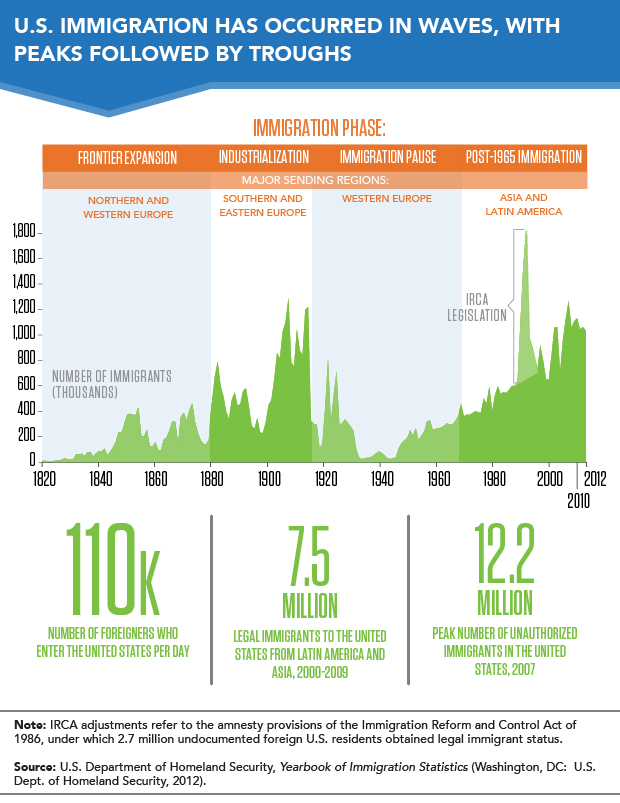Immigration is widely considered to be in the national interest since it permits individuals to better themselves as it strengthens the United States.
For its first 100 years, the United States facilitated immigration, welcoming foreigners to settle a vast country. Beginning in the 1880s, an era of qualitative immigration restrictions began as certain types of immigrants were barred: prostitutes, workers with contracts that tied them to a particular employer for several years, and Chinese. In the 1920s, quantitative restrictions or quotas set a ceiling on the number of immigrants accepted each year.
During the 1970s, the origins of most immigrants changed from Europe to Latin America and Asia: Between 2000 and 2009 over three-fourths of the 10 million immigrants admitted were from Latin America and Asia.

U.S. immigration has occurred in waves, with peaks followed by troughs (see figure). The first wave of immigrants, mostly English speakers from the British Isles, arrived before records were kept beginning in 1820. The second wave, dominated by Irish and German Catholics in the 1840s and 1850s, challenged the dominance of the Protestant church and led to a backlash against Catholics, defused only when the Civil War practically stopped immigration in the 1860s.
The third wave, between 1880 and 1914, brought over 20 million European immigrants to the United States, an average of 650,000 a year at a time when the United States had 75 million residents. Most southern and eastern European immigrants arriving via New York’s Ellis Island found factory jobs in Northeastern and Midwestern cities. Third-wave European immigration was slowed first by World War I and then by numerical quotas in the 1920s.
Between the 1920s and 1960s, immigration paused. Immigration was low during the Depression of the 1930s, and in some years more people left the United States than arrived. Immigration rose after World War II ended, as veterans returned with European spouses and Europeans migrated. The fourth wave began after 1965, and has been marked by rising numbers of immigrants from Latin America and Asia. The United States admitted an average 250,000 immigrants a year in the 1950s, 330,000 in the 1960s, 450,000 in the 1970s, 735,000 in the 1980s, and over 1 million a year since the 1990s.

The House approved an enforcement-first bill in 2005 and has opted for a piecemeal approach to immigration reform in 2013, with bills that increase border and interior enforcement and expand guest worker programs for farm and information technology (IT) workers.
9,029X
Register now and find your lost patrimony after your ancestors.





